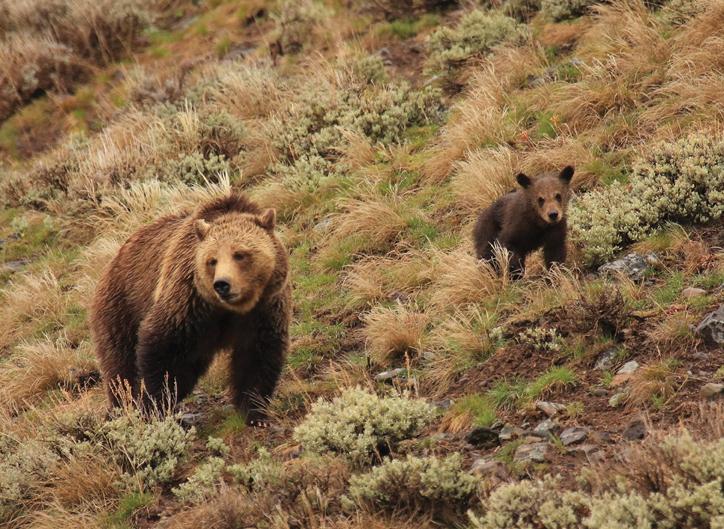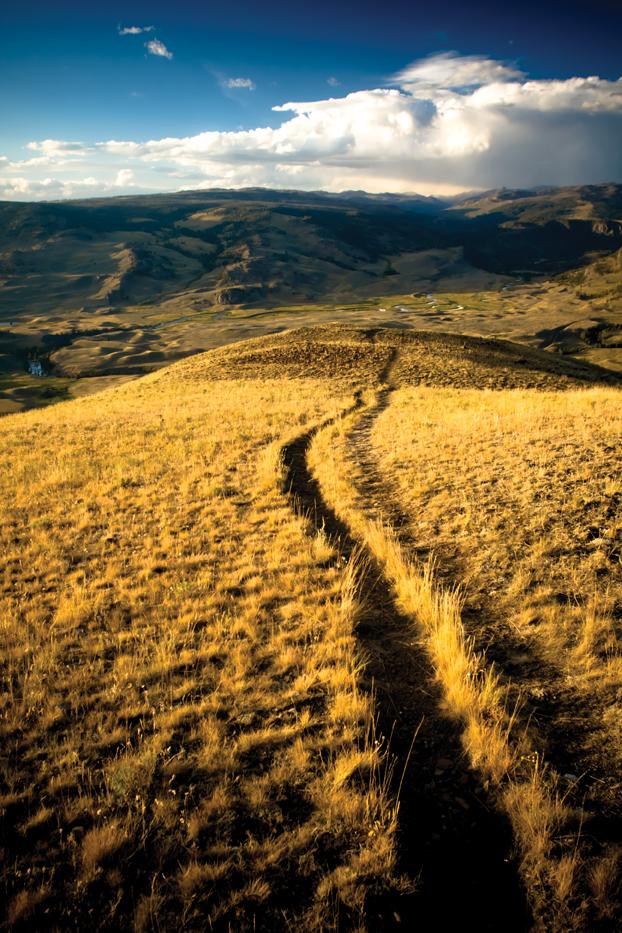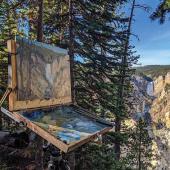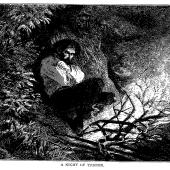The Yellowstone Question
In the early morning of July 10, 2010, a sow grizzly and two cubs attacked three people, in three different campsites, as they slept in their tents. Two of the people were injured while the third was killed and partially eaten.
The incident, which occurred a stone’s throw from Yellowstone National Park’s northeastern boundary in the Soda Butte Campground, was my first thought when my brother asked, “How about Yellowstone?” Our Continental Divide trip over the long 4th of July weekend had to be scrapped due to huge amounts of snow still lingering in the mountains. So we were left scrambling to find an adventure.
“Yellowstone?” I asked.
“Yeah, why not? We’ve lived two hours away for over five years and have barely seen any of the backcountry.”
I said I would get back to him. He told me not to dawdle too long—time and tide and so forth.
“The Yellowstone Question” has two contradictory answers. On the one hand, hikers and backpackers salivate when Park gates open, its vastness spread out before them like the open sea. It’s the kind of place Muir was talking about when he said, “Throw a loaf of bread and a pound of tea in an old sack and jump over the back fence.” And the variety—high mountain passes and scraggly peaks, boundless prairies melting into the sky, spewing geysers, lodgepole pine forests, deep lakes of clear water, cottonwood-banked rivers teeming with trout—is unlike anything else in the world.
On the other hand is a darker, almost sinister answer: grizzly bears. To residents of southwest Montana, bears are just another potato in the stew of Montana. Wherever you camp, you mind your crumbs. Wherever you hike, you holler. Bears eat out of trashcans in town, and even frequent the dumpsters at K-Mart. We learn to endure bears and tourists similarly: they arrive in numbers once the weather warms, invade campgrounds and hiking trails, hate your mountain bike, and have no interest in obeying local traffic laws. Remain calm, avoid eye contact, and back away slowly. Like any routine hazard, we learn how to deal.
But Yellowstone is different. This is not the realm of nature-savvy outdoorsfolk in Ford Escapes and skittish black bears under the impression that they’re encroaching. Quite the opposite—in Yellowstone, you’re dealing with massive Ford Super Duties pulling three-bedroom luxury suites and 600-pound grizzlies annoyed that you’re invading their territory.
In 1975, the grizzly population in the Park plummeted to a staggeringly low 136 bears. Something drastic needed to be done to save the Yellowstone bears from complete annihilation—and with careful management, the 2005 population reached 500. By 2007, grizzlies were abundant enough to be removed from the endangered species list (to which they were later reinstated, but more as a precautionary measure due to the inconsistency of their food supply). By 2011, 600 grizzlies roamed Yellowstone. Because of that number, I was always content to see the Park through a windshield or from a paved pullout surrounded by a bus full of Koreans.
But such contentment fades when you work as the assistant to a maintenance man at a crummy hotel and have a two-year-old boy who thinks you’re Zeus. I suppose my brother’s question came at one of those moments where I wanted to prove my boy right. So that’s how I came to find myself driving south through Paradise Valley in the gathering light of July 2, 2011.
I was anxious, but not that pre-trip anxious where I couldn’t wait to get out of the car. This was more “meet the parents” anxious. By the time we reached the stone arch of the Gardiner entrance to Yellowstone, I had chain-smoked four cigarettes in an attempt to calm my nerves. Once we paid the lady in the ten-gallon ranger hat, I couldn’t come up with a single excuse for turning back. Then, like lazy surf rolling over smooth stones, I was soothed. Patches of purples and reds, violets and lavenders from the myriad of wildflowers in bloom exploded from the soil. It didn’t seem to be created by random acts of fire, wind, and water, but by an artist whose eye for detail didn’t neglect the placement of a single stone.
On the way to Mammoth, we drove slowly and spoke little. At the backcountry ranger station, we got our affairs in order and proceeded up to the Blacktail Deer Plateau and Hellroaring Trailhead. We threw on our packs, shared a quick uncertain glance, and dove headfirst into the Yellowstone backcountry.
We walked less than 100 feet and stopped dead at the edge of a plateau overlooking the Lamar River and its vast valley. Switchbacking our way down, we remarked how funny it was to start out a hike by going downhill—something neither of us had done. We moved with purpose, passing day hikers, stopping occasionally to take in the view or examine wildflowers. I had expected the trail to be busy, and for the first mile it was. And then we were alone. Everybody else disappeared and it was just us and miles of emptiness.
At the first trail junction, we took out the map to confer and spent five minutes talking about our current route, then another ten planning future excursions on the trails we had to pass. We turned to continue, but less than ten feet away was what looked like a fur-covered bus with horns—a big ol’ Tatonka. He was lying in the long grass as we approached; he stood up and we just stared at one another. My brother finally choked out the sound “Uhhhh?” It sounds ridiculous now but it was the only question the present situation granted asking. The buffalo responded with a lazy shake of his head and then lumbered away. When he was a safe distance off my brother laughed, “Glad that wasn’t a griz.” I didn’t respond.
Over the next three days, I stopped every so often to fish in the Yellowstone, chock-full of trout that wanted nothing to do with my lures—in three days of fishing I caught a single rainbow, and I’m pretty sure he was just showing me some pity. In the lingering twilight of the western summer, we lounged around a fire or along the banks of the river, got tipsy on rye alcohol, and waxed philosophic. When the fire burned low, we shuffled off to bed and slept like rich men. The idea of bears, or six-inch razor-sharp claws, or bone-crushing jaws, was as distant as the moon.
After three days in the backcountry, we reached the road and hitchhiked back to our car. I had already planned out six trips in the Park that I wanted to do before the end of the summer, and had made the drunken claim that I refused to ever do any backpacking outside the Park again because nothing else could compare. Then…
On July 6, Brian and Marylyn Matayoshi were hiking in the Wapiti Lake region of the Park when they came upon a sow grizzly and two cubs. Brian was mauled and killed while Marylyn was attacked but relatively unharmed. The Greater Yellowstone region was in shock and the Park Service was quick in mentioning that this had been the first fatal bear attack in 25 years. Before questions could be answered or unrest could be quelled, it happened again. On August 26, two hikers discovered the mauled body of John Wallace on the Mary Mountain Trail. Hair samples found at the scene linked the same sow grizzly that had attacked the Matayoshis to the Wallace attack. The sow, as with the bear from the Soda Butte incident the year prior, was found and killed. Further investigation uncovered DNA from at least four separate grizzlies at or near the site where Wallace’s body was found; investigators concluded there was no clear evidence to identify which bear killed him.
I didn’t go back to the Park again that summer, though it was never far from my thoughts. Aldo Leopold said, “There are those who can live without wild places, and those who can’t.” Yellowstone gives people who can’t some peace of mind—as long as it’s there, salvation is never far away. And yet the attacks seemed to contradict this, leaving me to ask, what is Yellowstone National Park? Is it a lifetime of adventure for people who love wearing out hiking boots? Or simply a cageless zoo? And who is it for? Is it for us? A place where the grinding of life and labor and the endless obstructions of man are totally void, where we can look out on a place unhindered by the hand of humankind? Or is it a place where animals can live in some sense of normalcy and freedom as they once did? Is it both? And if so, is that a realistic objective? Can millions of people, millions of cars, and hundreds, maybe eventually thousands of bears, coexist with any real sense of normalcy? I don’t have the answers. All I know is that since 2010, three people have died, two bears have been euthanized, one has its head on the chopping block, four cubs have been placed in captivity, and I spent three days in a place I want to consider heaven.













